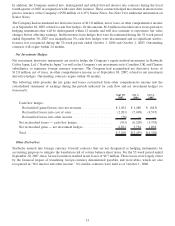Starbucks 2007 Annual Report Download - page 50
Download and view the complete annual report
Please find page 50 of the 2007 Starbucks annual report below. You can navigate through the pages in the report by either clicking on the pages listed below, or by using the keyword search tool below to find specific information within the annual report.Operating Leases
Starbucks leases retail stores, roasting and distribution facilities and office space under operating leases. Most lease
agreements contain tenant improvement allowances, rent holidays, lease premiums, rent escalation clauses and/or
contingent rent provisions. For purposes of recognizing incentives, premiums and minimum rental expenses on a
straight-line basis over the terms of the leases, the Company uses the date of initial possession to begin amortization,
which is generally when the Company enters the space and begins to make improvements in preparation of intended
use.
For tenant improvement allowances and rent holidays, the Company records a deferred rent liability in “Accrued
occupancy costs” and “Other long-term liabilities” on the consolidated balance sheets and amortizes the deferred
rent over the terms of the leases as reductions to rent expense on the consolidated statements of earnings.
For premiums paid upfront to enter a lease agreement, the Company records a deferred rent asset in “Prepaid
expenses and other current assets” and “Other assets” on the consolidated balance sheets and then amortizes the
deferred rent over the terms of the leases as additional rent expense on the consolidated statements of earnings.
For scheduled rent escalation clauses during the lease terms or for rental payments commencing at a date other than
the date of initial occupancy, the Company records minimum rental expenses on a straight-line basis over the terms
of the leases on the consolidated statements of earnings.
Certain leases provide for contingent rents, which are determined as a percentage of gross sales in excess of
specified levels. The Company records a contingent rent liability in “Accrued occupancy costs” on the consolidated
balance sheets and the corresponding rent expense when specified levels have been achieved or when management
determines that achieving the specified levels during the fiscal year is probable.
Asset Retirement Obligations
Starbucks accounts for asset retirement obligations under Financial Accounting Standards Board (“FASB”)
Interpretation No. 47 (“FIN 47”), “Accounting for Conditional Asset Retirement Obligations — an interpretation
of FASB Statement No. 143,” which it adopted at the end of fiscal 2006. FIN 47 requires recognition of a liability for
the fair value of a required asset retirement obligation (“ARO”) when such obligation is incurred. The Company’s
AROs are primarily associated with leasehold improvements which, at the end of a lease, the Company is
contractually obligated to remove in order to comply with the lease agreement. At the inception of a lease with such
conditions, the Company records an ARO liability and a corresponding capital asset in an amount equal to the
estimated fair value of the obligation. The liability is estimated based on a number of assumptions requiring
management’s judgment, including store closing costs, cost inflation rates and discount rates, and is accreted to its
projected future value over time. The capitalized asset is depreciated using the convention for depreciation of
leasehold improvement assets. Upon satisfaction of the ARO conditions, any difference between the recorded ARO
liability and the actual retirement costs incurred is recognized as an operating gain or loss in the consolidated
statement of earnings.
Total ARO expense in fiscal 2007 was $4.2 million with components included in “Costs of sales including
occupancy costs,” “Depreciation and amortization expenses” and “Income from equity investees.” The initial
impact of adopting FIN 47 at the end of fiscal year 2006 was a charge of $27.1 million, with a related tax benefit of
$9.9 million, for a net expense of $17.2 million; as required by FIN 47, the net amount was recorded as a cumulative
effect of a change in accounting principle on the consolidated statement of earnings for fiscal year 2006. As of
September 30, 2007 and October 1, 2006, the Company’s net ARO asset included in “Property, plant and equipment,
net” was $20.2 million and $15.5 million, respectively, while the Company’s net ARO liability included in “Other
long-term liabilities” was $43.7 million and $34.3 million, on the same respective dates.
Stock-based Compensation
The Company maintains several equity incentive plans under which it may grant non-qualified stock options,
incentive stock options, restricted stock, restricted stock units (“RSUs”) or stock appreciation rights to employees,
non-employee directors and consultants. The Company also has employee stock purchase plans (“ESPP”). RSUs
48
























